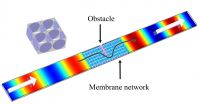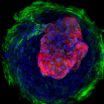(Press-News.org) WASHINGTON, DC, July 14, 2015 -- When a sound wave hits an obstacle and is scattered, the signal may be lost or degraded. But what if you could guide the signal around that obstacle, as if the interfering barrier didn't even exist? Recently, researchers at Nanjing University in China created a material from polyethylene membranes that does exactly that.
Their final product, described this week in the Journal of Applied Physics, from AIP Publishing, was an acoustical "metamaterial" with an effective density near zero (DNZ). This work could help to endow a transmission network with coveted properties such as high transmission around sharp corners, high-efficient wave splitting, and acoustic cloaking.
"It's as if the entire [interior] space is missing," said Xiaojun Liu, a professor in the physics department at Nanjing University's Collaborative Innovation Center of Advanced Microstructures.
"We were curious about whether we could make a simple but compact density-near-zero metamaterial from just a few tiny membranes," Liu said, "and, if so, can we further manipulate sound and make acoustic invisibility cloaks and other strange functional devices?"
Previous prototypes had attempted to achieve density-near-zero by using coiled structures and phononic crystals to create "Dirac cones," but required large physical dimensions, complex geometric structures, and the difficult feat of slowing sound waves to extremely low velocities within scattering cylinders to be effective -- limiting their practical applications.
Their current paper proposes a physical, minimalist realization of their original density-near-zero idea, consisting of 0.125 mm-thick polyethylene membranes perforated with 9-millimeter-radius holes in a square grid inside of a metal waveguide, a physical structure for guiding sound waves. The intensive resonances of the membranes significantly reduce the structure's effective mass density, which is a measure of its dynamic response to incident sound waves. By Newton's second law, this reduction causes the average acceleration of the structure to approach infinity, which gives rise to sound tunneling.
When sound at a frequency of 990 Hz is then conducted and rapidly accelerated through the material, the membranes act as a tunnel for sound, encapsulating the waves into local subwavelength regions. This arrangement allows the sound waves to pass through without accumulating a phase change or distorting the wavefront -- analogous to the quantum tunneling effect, in which a particle crosses through a potential energy barrier otherwise insurmountable by classical mechanics.
For future applications, the metamaterial would likely be integrated into acoustic circuits and structures. When implemented in a wave splitter, the researchers found an 80 percent increase in the efficiency of energy transmission, regardless of the wave's incident angle.
Additionally, the researchers are able to tune the frequency of the metamaterial network by altering the membrane's tension and physical dimensions, which they were unable to do in previous prototypes.
Liu and his colleagues have already used the membrane network to fabricate a planar hyperlens, a device which magnifies one and two-dimensional objects on the subwavelength scale to compensate for the losses of acoustic waves carrying fine details of images as they pass a lens. This can allow scientists to see fine features of objects such as tumors, or minute flaws within airplane wings in industrial testing, that may otherwise be unobservable due to an instrument's diffractive limit. Additional planned applications include using smart acoustic structures, such as logic gates that can control acoustic waves by altering their propagation, for communication systems in environmental conditions too extreme for conventional electronic devices and photonic structures.
"The vanishing mass density we've demonstrated is definitely more than a mathematical trick," said Liu.
INFORMATION:
The article, "Controlling sound transmission with density-near-zero acoustic membrane network," is authored by Yuan Gu, Ying Cheng, Jingshi Wang and Xiaojun Liu. It will appear in the Journal of Applied Physics on July 14, 2015 (DOI: 10.1063/1.4922669). After that date, it can be accessed at: http://scitation.aip.org/content/aip/journal/jap/118/2/10.1063/1.4922669
ABOUT THE JOURNAL
Journal of Applied Physics is an influential international journal publishing significant new experimental and theoretical results of applied physics research. http://jap.aip.org
A quick biological test may be able to identify children who have literacy challenges or learning disabilities long before they learn to read, according to new research from Northwestern University.
The study, publishing in the Open Access journal PLOS Biology on July 14th, centers on the child's ability to decipher speech -- specifically consonants -- in a chaotic, noisy environment. Preliterate children whose brains inefficiently process speech against a background of noise are more likely than their peers to have trouble with reading and language development when ...
A yearlong study of more than 300 patients found that the investigational drug patiromer can reduce elevated blood-potassium levels--a common side effect of drugs essential in the treatment of chronic diabetic kidney disease.
The drug, given in this trial at one of four doses based on disease severity, returned blood potassium levels to normal when measured at four weeks and kept them under control for one year, the length of the trial. By quickly bringing potassium levels back to normal and keeping them there, patiromer can prevent life-threatening adverse events.
The ...
The new guidelines for determining whether patients should begin taking statins to prevent cardiovascular disease issued in 2013 by the American College of Cardiology (ACC) and the American Heart Association (AHA) are more accurate and more efficient than an earlier set of guidelines in assigning treatment to adults at increased risk for cardiovascular events - including heart attacks and strokes - and identifying those whose low risk rules out the need to take statins. In their paper appearing in the July 15 issue of JAMA, a team led by Massachusetts General Hospital (MGH) ...
An examination of the 2013 guidelines for determining statin eligibility, compared to guidelines from 2004, indicates that they are associated with greater accuracy and efficiency in identifying increased risk of cardiovascular disease (CVD) events and presence of subclinical coronary artery disease, particularly in individuals at intermediate risk, according to a study in the July 14 issue of JAMA.
The 2013 American College of Cardiology/American Heart Association (ACC/AHA) guidelines for the management of blood cholesterol represent a shift in the treatment approach ...
A microsimulation model-based analyses suggests that the health benefits associated with the 10-year atherosclerotic cardiovascular disease risk threshold of 7.5 percent or higher used in the 2013 ACC-AHA cholesterol guidelines are worth the additional costs required to achieve these health gains, and that a more lenient threshold might also be cost-effective, according to a study in the July 14 issue of JAMA.
In November 2013 the American College of Cardiology and the American Heart Association (ACC/AHA) released new recommendations to guide statin treatment initiation ...
Among patients with diabetic kidney disease and hyperkalemia (elevated potassium levels in the blood), a potentially life-threatening condition, those who received the new drug patiromer, twice daily for four weeks, had significant decreases in potassium levels which lasted through one year, according to a study in the July 14 issue of JAMA.
Patients at the highest risk for hyperkalemia are those taking renin-angiotensin-aldosterone system (RAAS) inhibitors with stage 3 or greater chronic kidney disease (CKD) who also have diabetes mellitus, heart failure, or both. Because ...
An examination of state vaccination requirements for adolescents finds that the human papillomavirus (HPV) vaccine is currently required in only two states, many fewer than another vaccine associated with sexual transmission (hepatitis B) and another primarily recommended for adolescents (meningococcal conjugate), according to a study in the July 14 issue of JAMA.
Eight years after HPV vaccines were first recommended in the United States, vaccination coverage is substantially below the Healthy People 2020 target of 80 percent. Data from the U.S. Centers for Disease Control ...
Berkeley -- Researchers at the University of California, Berkeley, in collaboration with scientists at the Gladstone Institutes, have developed a template for growing beating cardiac tissue from stem cells, creating a system that could serve as a model for early heart development and a drug-screening tool to make pregnancies safer.
In experiments to be published Tuesday, July 14, in the journal Nature Communications, the researchers used biochemical and biophysical cues to prompt stem cells to differentiate and self-organize into micron-scale cardiac tissue, including ...
Boston, MA - A new study from Harvard T.H. Chan School of Public Health researchers has found that it would be cost-effective to treat 48-67% of all adults aged 40-75 in the U.S. with cholesterol-lowering statins. By expanding the current recommended treatment guidelines and boosting the percentage of adults taking statins, an additional 161,560 cardiovascular-related events could be averted, according to the researchers.
"The new cholesterol treatment guidelines have been controversial, so our goal for this study was to use the best available evidence to quantify the ...
WASHINGTON, DC --July 14, 2015--Multiple species of bacteria working together in healthy guts are responsible for keeping out nasty bacterial invader, Clostridium difficile, a hospital-acquired culprit responsible for 15,000 deaths each year. The study, published this week in mBio, the online open-access journal of the American Society for Microbiology, could lead to tests to predict which hospital patients are at highest risk of infection and better management of infections.
"Hospital-acquired C. difficile infections have bloomed as a problem in the last 10-15 years, ...

